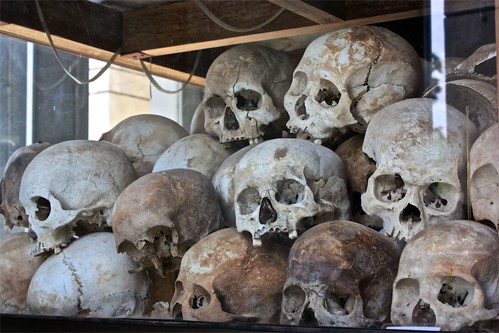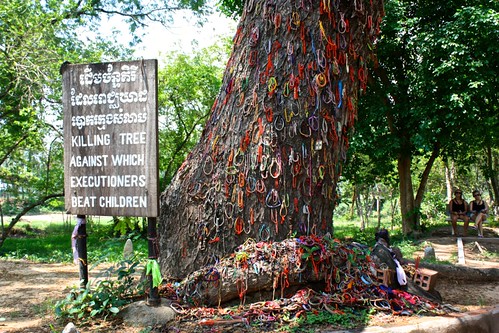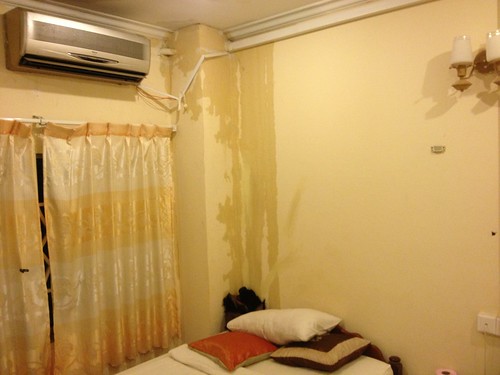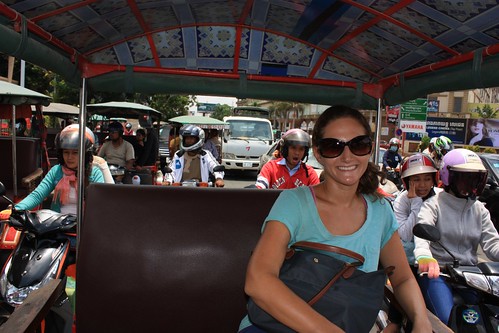Phnom Penh is hot, crowded, and evidently prone to torrential downpours. It's also a good place to understand Cambodia's all-too-recent history and a stop here is basically unavoidable if you're coming from elsewhere in the country (or the region). While we can't say we loved the city, we did think it worth at least a day.
Sights and Activities
Phnom Penh has two things in common with other large SE Asian cities—huge markets and tons of traffic. If you're new to the region, observing this craziness alone can take an entire afternoon. But if you're short on time, or just keen to get to the beach like we were, then there are a few other "must sees" in Phnom Penh that you should prioritize.
The Royal Palace and Silver Pagoda sit close to the waterfront and appeared a lot less garish than the Bangkok version. Because our funds were low and our pagoda limit was approaching dangerously high levels, we only walked around the grounds. But if this is your first Asian city, then seeing the architecture up close is definitely worth it.

What we had on our list were the National Museum and the Killing Fields of Choeung Ek. The National Museum, to our dismay, wasn't air conditioned and raised their prices from $2 to $5. We decided to skip it in favor of the Killing Fields outside of town.
While not a picturesque attraction by any means, the Killing Fields are an easy, and illustrative, way to get a good understanding of Cambodia's recent bloody history. There are hundreds of killing fields throughout the country, but the one at Choeung Ek is the largest. It's $2 to enter and an additional $3 for the audio tour, which is highly recommended.

While there isn't much to see in the field itself, there's enough information on the tour to make you both angry and sad. In 1975, a leader name Pol Pot took over the country with the insane (and all too common) goal of making it a completely communistic peasant-led society. His Khmer Rouge government stormed cities and forced urban dwellers, with no farming experience, out into the fields. The aim was simple: give the country back to the farmers/peasants, the truly noble ones. But, of course, the execution was horrific.
Under the Khmer Rouge, 25% of the country perished, some from exhaustion and famine, others from murder. As with many similar rulers, Pol Pot feared the intellectuals, which meant they were the first to go. Anyone with an education, anyone who spoke another language or wore glasses, teachers, doctors, lawyers, etc. were rounded up and sent to Security Prison 21 (S-21) in Phnom Penh, which was, ironically, a former school. Here they were tortured until they admitted crimes against the state that they never actually committed, until they implicated their neighbors, and until they basically lost the will to live.
Once that happened, they were transferred to Choeung Ek. They arrived blindfolded at night and were immediately murdered—by ax, by tree trunk, by hoe, by anything that cost minimal money. Like the Nazis, the Khmer Rouge didn't want to waste precious bullets on ending lives and so they literally bludgeoned their victims to death. The most disturbing site at the fields, aside from the hundreds of human skulls on display, is the Killing Tree, a tree Khmer Rouge soldiers smashed babies against until they died.

TIP: When you're frustrated at a local's apparent lack of understanding (or interest), remember what happened to this country just a few decades ago
They're still in recovery mode, and most of their intellectuals were killed off...
The Killing Fields certainly isn't a light stop, but it is an important one. Nothing better makes you grasp the possible power of one crazy person than seeing the horror that he created—less than 40 years ago, and three decades after WWII. The worst part is that many of the war criminals from the Khmer Rouge time are still awaiting international trial, which likely means they'll never be sentenced.
Fun and disturbing fact: The Cambodian government privatized the Killing Fields and leased them to a Japanese company for a nominal sum. Talk about profiting off of past horror. Needless to say, the families of victims aren't happy.
Hotels
Cities are always the hardest places to find a hotel, and it gets a lot worse when you arrive in the middle of a torrential downpour that has flooded entire blocks. After a few minutes looking around during a break in the storm, we settled on Modern City Hotel. It was close to the water and looked decent, but it was possibly the worst place we've ever stayed.

During our first 30 minutes, there was an electrical fire on our floor that wiped out electricity. We were assured everything was fixed, but when we came back the next day after sightseeing (and another storm) our room was flooded with water. Thankfully, not much got wet, but the whole experience was awful. We were given another room, with a dead cockroach on the floor. It was $15/night, but whatever you do, don't go there. We saw this on our wall in our first room when we were leaving. I wish we would have seen it sooner.

The whole experience so traumatized Rob that he spent the following night creating an offline version of TripAdvisor for us to use in the future. Now whenever we show up to a new place, we have reviews for all the available hotels/guesthouses at our fingertips. Before we walk in somewhere, we double check the reviews to make sure it's not awful. Yay, Rob!
Velkommen Guesthouse and Sundance are both supposed to be nice, though they were completely booked when we tried a few days before our arrival. There's another backpacker area in south central Phnom Penh, but we wanted to be close to the river and the palace.
TIP: If you're looking to stay by the water in a budget place, book ahead
They fill up fast!
Food and Drink
We were only there for one day, so none of the food we had really blew our minds. There are plenty of $0.50 beer places by the water with varying quality of food, but typically more crowded means better. We had a yummy and cheap dinner at Dragon House on street 130 and a good lunch during the rainstorm on our second day at Warong Bali, an Indonesian place close to the palace and museum.
TIP: If you're in Phnom Penh around rainy season, do your outdoor sightseeing in the morning
It seems to storm most afternoons.
Transport
Forget about renting a motorbike unless you're from a place where they drive even crazier than here. We bargained (way) down for a tuk-tuk to the Killing Fields for $7, or you can do a half-day tour for $5 each that includes both the fields and S-21.

Buses to everywhere in the country are abundant from here. We headed to Sihanoukville for $5 each.
More Phnom Penh
Interested in seeing Phnom Penh and the Killing Fields without paying for a plane ticket? Check out our Phnom Penh photo tour.
Have any tips for budget travel in Phnom Penh? Let us know in the comments!
Comments